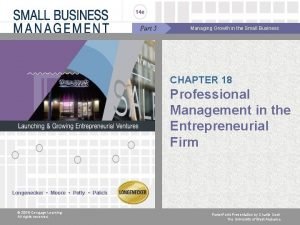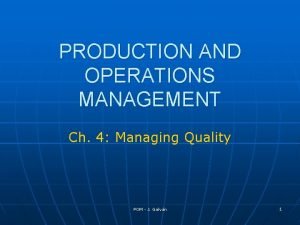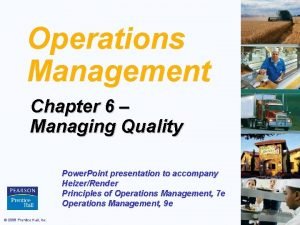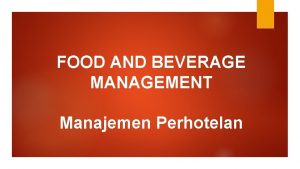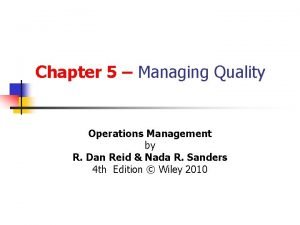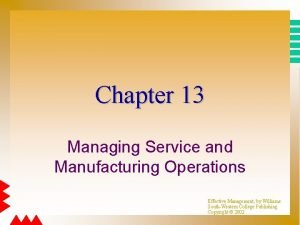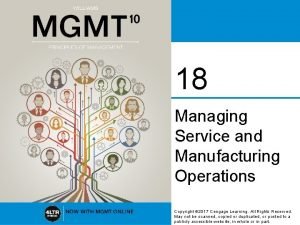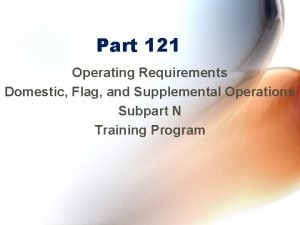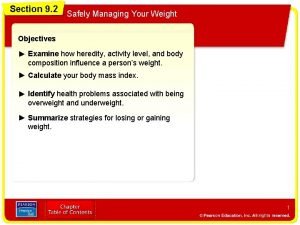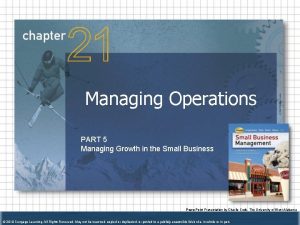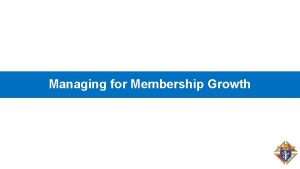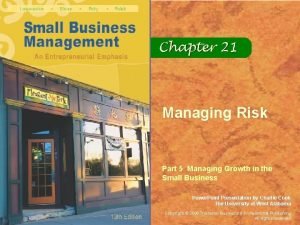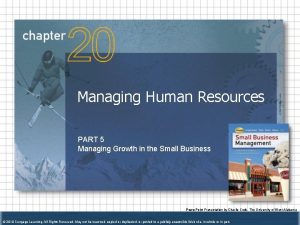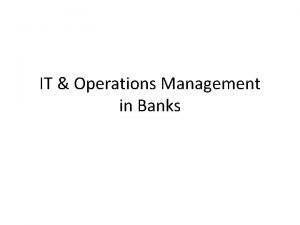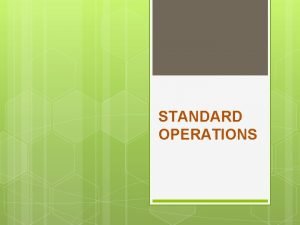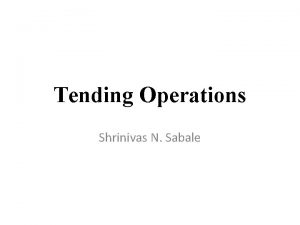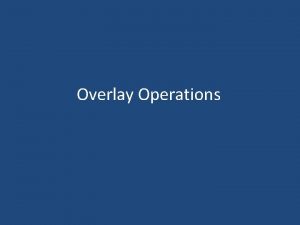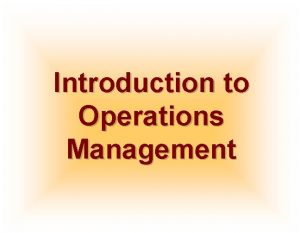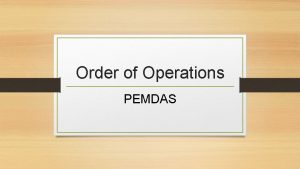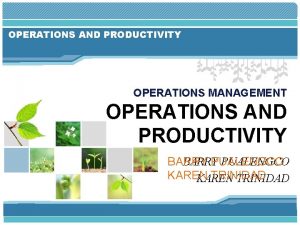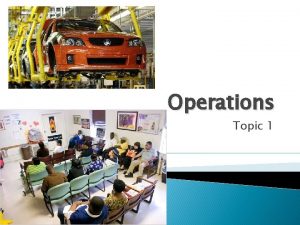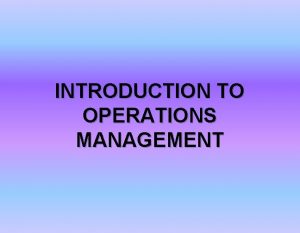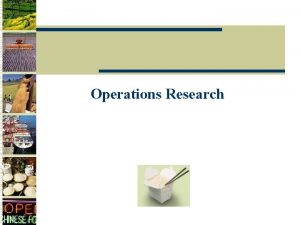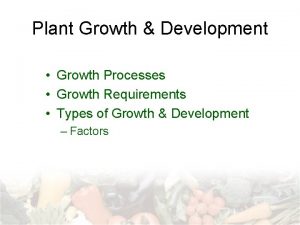Managing Operations PART 5 Managing Growth in the
























- Slides: 24

Managing Operations PART 5 Managing Growth in the Small Business Power. Point Presentation by Charlie Cook, The University of West Alabama © 2010 Cengage Learning. All Rights Reserved. May not be scanned, copied or duplicated, or posted to a publicly accessible Web site, in whole or in part.

Competing with Operations • Operations Ø The processes used to create and deliver a good or service (value) to customers. • Operations Management Ø The planning and control of a conversion process that includes turning inputs into outputs (products and/or services) that customers desire. 21– 2 © 2010 Cengage Learning. All Rights Reserved. May not be scanned, copied or duplicated, or posted to a publicly accessible Web site, in whole or in part.

Competing with Operations (cont’d) • Important Questions about Operations Factors: Ø How much flexibility is required to satisfy customers over time? Ø What is customer demand today? for the future? Are facilities and equipment adequate to keep up with demand? Ø What options are available for satisfying customers? Ø What skills or capabilities set the firm apart from its competitors such that the firm can best take advantage of these distinctive features in the market? Ø Does the competitive environment require certain capabilities that the enterprise lacks? 21– 3 © 2010 Cengage Learning. All Rights Reserved. May not be scanned, copied or duplicated, or posted to a publicly accessible Web site, in whole or in part.

The Operations Process • Managing Operations in a Service Business Ø Products are tangible, services are intangible. v Manufacturing can produce goods for inventory; service operations cannot store or bank services. v Productivity and quality is more easily measured in manufacturing than service operations. v Quality is more difficult and control to establish in service than manufacturing operations. v Customers are more involved in service than manufacturing operations and can influence the quality of service. v Technology can enable customers to provide more of their own services. 21– 4 © 2010 Cengage Learning. All Rights Reserved. May not be scanned, copied or duplicated, or posted to a publicly accessible Web site, in whole or in part.

Exhibit 21. 1 The Operations Processes (Input Processes Output) 21– 5 © 2010 Cengage Learning. All Rights Reserved. May not be scanned, copied or duplicated, or posted to a publicly accessible Web site, in whole or in part.

The Operations Process (cont’d) • Capacity Considerations Ø Capacity limits firm’s ability to meet demand Ø Capacity determines startup (fixed) costs Ø Ability to adjust capacity differs among firms • Planning and Scheduling Ø Involves attempting to achieve the orderly, sequential flow of products or services to market. Ø Is critical in service industry operations Ø Incorporates demand management strategies to stimulate customer demand when it is normally low. 21– 6 © 2010 Cengage Learning. All Rights Reserved. May not be scanned, copied or duplicated, or posted to a publicly accessible Web site, in whole or in part.

Inventory Management and Operations • Objectives of Inventory Management 21– 7 © 2010 Cengage Learning. All Rights Reserved. May not be scanned, copied or duplicated, or posted to a publicly accessible Web site, in whole or in part.

Inventory Management and Operations (cont’d) • ABC Inventory Classification Ø Classifying items in inventory by relative value: v Category A (close/continuous control) – High-value or critical production component items v Category B (moderate control) – Less costly, secondary importance items v Category C (periodic control) – Low-cost and noncritical items 21– 8 © 2010 Cengage Learning. All Rights Reserved. May not be scanned, copied or duplicated, or posted to a publicly accessible Web site, in whole or in part.

Inventory Management and Operations (cont’d) • Just-In-Time Inventory (JIT) System Ø A demand (pull) method of reducing inventory level to an absolute minimum. v New inventory items arrive at the same time that the last inventory item is placed in service. Ø JIT promotes: v v v Closer coordination with suppliers Consistent quality production Lower safety stock levels 21– 9 © 2010 Cengage Learning. All Rights Reserved. May not be scanned, copied or duplicated, or posted to a publicly accessible Web site, in whole or in part.

Inventory Record-Keeping Systems • Physical inventory system Ø Provides for periodic counting of items in inventory. • Cycle counting Ø Counts different segments of the physical inventory at different times during the year. • Perpetual inventory Ø Keeps a running record of inventory that does not require a physical count except to ensure the accuracy of the system. • Two-bin inventory system Ø A method of inventory control based on use of two containers for each item in inventory: one to meet current demand the other to meet future demand. 21– 10 © 2010 Cengage Learning. All Rights Reserved. May not be scanned, copied or duplicated, or posted to a publicly accessible Web site, in whole or in part.

Operations Management and Quality • Quality as a Competitive Tool Ø Quality is a must in international competition • Quality Ø The features of a product or service that enable it to satisfy customers’ needs. Ø A perception of the customer as to the suitability of the product or service of a firm. • Total Quality Management (TQM) Ø An aggressive, all-encompassing management approach to providing superior, high-quality products and services. 21– 11 © 2010 Cengage Learning. All Rights Reserved. May not be scanned, copied or duplicated, or posted to a publicly accessible Web site, in whole or in part.

Tools and Techniques of TQM • Employee Participation Ø Employee performance is a critical quality variable. Ø The implementation of work teams and empowerment of employees to build workplace involvement. Ø Quality circle v A group of employees who meet regularly to discuss quality-related problems. 21– 12 © 2010 Cengage Learning. All Rights Reserved. May not be scanned, copied or duplicated, or posted to a publicly accessible Web site, in whole or in part.

Exhibit 21. 3 Essential Features of Total Quality Management 21– 13 © 2010 Cengage Learning. All Rights Reserved. May not be scanned, copied or duplicated, or posted to a publicly accessible Web site, in whole or in part.

Customer Focus of Quality Management • Customer Expectations Ø Quality is the extent to which a product or service satisfies customer’s needs and expectations. v v v Product quality Service quality Product and service quality combinations Ø “The customer is the focal point of quality efforts. ” • Customer Feedback Ø Customers are the eyes and ears of the business for quality matters. 21– 14 © 2010 Cengage Learning. All Rights Reserved. May not be scanned, copied or duplicated, or posted to a publicly accessible Web site, in whole or in part.

Quality Assurance Using Inspection versus Poka-Yoke • The Inspection Process Ø The examination of a product to determine whether it meets quality standards. Ø Occurs after the fact—the defective good has already been produced. • Poka-Yoke Ø A proactive approach to quality management that seeks to mistake-proof a firm’s operations, thus avoiding problems and waste before they can occur. 21– 15 © 2010 Cengage Learning. All Rights Reserved. May not be scanned, copied or duplicated, or posted to a publicly accessible Web site, in whole or in part.

Statistical Methods of Quality Control • Acceptance Sampling Ø The use of a random, representative portion to determine the acceptability of an entire lot. • Attributes Ø Product or service parameters that can be counted as being present or absent. • Variables Ø Measured parameters that fall on a continuum, such as weight or length. 21– 16 © 2010 Cengage Learning. All Rights Reserved. May not be scanned, copied or duplicated, or posted to a publicly accessible Web site, in whole or in part.

Quality Management in Service Businesses • Opportunities for Small Service Companies Ø Providing an excellent combination of tangible products and intangible services. Ø Providing personalized, high contact services. Ø Providing service quality without regard to the profitability of the customer. Ø Developing good measures to control service quality. 21– 17 © 2010 Cengage Learning. All Rights Reserved. May not be scanned, copied or duplicated, or posted to a publicly accessible Web site, in whole or in part.

Purchasing Policies and Practices • Purchasing Ø The process of obtaining materials, equipment, and services from outside. • The Importance of Purchasing Ø The process of acquiring quality raw material inputs affects: v v v The timely and consistent production of quality products. Retailer sales of finished products to customers. The costs of products, their profitability and their selling prices. 21– 18 © 2010 Cengage Learning. All Rights Reserved. May not be scanned, copied or duplicated, or posted to a publicly accessible Web site, in whole or in part.

Purchasing Policies and Practices (cont’d) • Make-or-Buy Decisions Ø A firm’s choice between producing and purchasing component parts for its products. Ø Reasons for making: v v v Increased utilization of plant capacity Assurance of supply of critical components Maintaining secrecy in designs and processes Saving on transportation costs and supplier profits Closer coordination and control of overall process Higher quality components for inputs 21– 19 © 2010 Cengage Learning. All Rights Reserved. May not be scanned, copied or duplicated, or posted to a publicly accessible Web site, in whole or in part.

Purchasing Policies and Practices (cont’d) • Make or Buy Decisions (cont’d) Ø Reasons for Buying: v Outside supplier is cheaper and/or higher quality v Investment savings on space, personnel, equipment v Less diversified managerial experience and skills required v Greater flexibility in matching supply and demand v Increased focus on production of core products/services v Risk of obsolescence transferred to outsiders 21– 20 © 2010 Cengage Learning. All Rights Reserved. May not be scanned, copied or duplicated, or posted to a publicly accessible Web site, in whole or in part.

Purchasing Policies and Practices (cont’d) • Outsourcing Ø Purchasing products or services that are outside the firm’s area of competitive advantage. • Cooperative Purchasing Organization (COOP) Ø Small businesses combine demand for products or services to negotiate as a group with suppliers. v v Benefits: increased buying power, more access to resources and information Small firms save on inputs by using the Internet to seek out the lowest cost suppliers. 21– 21 © 2010 Cengage Learning. All Rights Reserved. May not be scanned, copied or duplicated, or posted to a publicly accessible Web site, in whole or in part.

Purchasing Policies and Practices (cont’d) • Diversifying sources of supply Ø Reasons for having a sole supplier: v v Outstanding supplier quality Quantity discounts for volume purchases Single orders too small to divide among suppliers Quality of supplier-customer relationship Ø Reasons for having multiple suppliers: v v v Choice of best quality, price, and service Supplier competes for business Insurance against input interruptions 21– 22 © 2010 Cengage Learning. All Rights Reserved. May not be scanned, copied or duplicated, or posted to a publicly accessible Web site, in whole or in part.

Purchasing Policies and Practices (cont’d) • Building Good Relationships with Suppliers Ø Pay bills promptly. Ø Give sales reps a timely and courteous hearing. Ø Minimize abrupt cancellation of orders merely to gain a temporary advantage. Ø Avoid attempts to browbeat a supplier into special concessions or unusual discounts. Ø Cooperate with the supplier by making suggestions for product improvements and/or cost reductions, whenever possible. 21– 23 © 2010 Cengage Learning. All Rights Reserved. May not be scanned, copied or duplicated, or posted to a publicly accessible Web site, in whole or in part.

Purchasing Policies and Practices (cont’d) • Forming Strategic Alliances with Suppliers Ø Involves close coordination of buyers and sellers to: v Reduce product introduction lead time v Improve product quality v Engage in joint problem solving v Make joint adjustments to market conditions v Involve the supplier early in product development 21– 24 © 2010 Cengage Learning. All Rights Reserved. May not be scanned, copied or duplicated, or posted to a publicly accessible Web site, in whole or in part.
 Relative growth rates
Relative growth rates Monocots vs eudicots
Monocots vs eudicots Carothers equation
Carothers equation Primary growth and secondary growth in plants
Primary growth and secondary growth in plants Vascular ray
Vascular ray Geometric vs exponential growth
Geometric vs exponential growth Neoclassical growth theory vs. endogenous growth theory
Neoclassical growth theory vs. endogenous growth theory Difference between organic and inorganic growth
Difference between organic and inorganic growth Managing growth in small business
Managing growth in small business Managing quality in operations management
Managing quality in operations management Chapter 6 managing quality
Chapter 6 managing quality Food and beverage operation cycle
Food and beverage operation cycle Managing quality in operations management
Managing quality in operations management Managing service and manufacturing operations
Managing service and manufacturing operations Managing service and manufacturing operations
Managing service and manufacturing operations Managing front office operations 10th edition
Managing front office operations 10th edition Part 121 operations
Part 121 operations Managing your weight part 2
Managing your weight part 2 Hát kết hợp bộ gõ cơ thể
Hát kết hợp bộ gõ cơ thể Lp html
Lp html Bổ thể
Bổ thể Tỉ lệ cơ thể trẻ em
Tỉ lệ cơ thể trẻ em Chó sói
Chó sói Tư thế worm breton là gì
Tư thế worm breton là gì Chúa yêu trần thế
Chúa yêu trần thế








